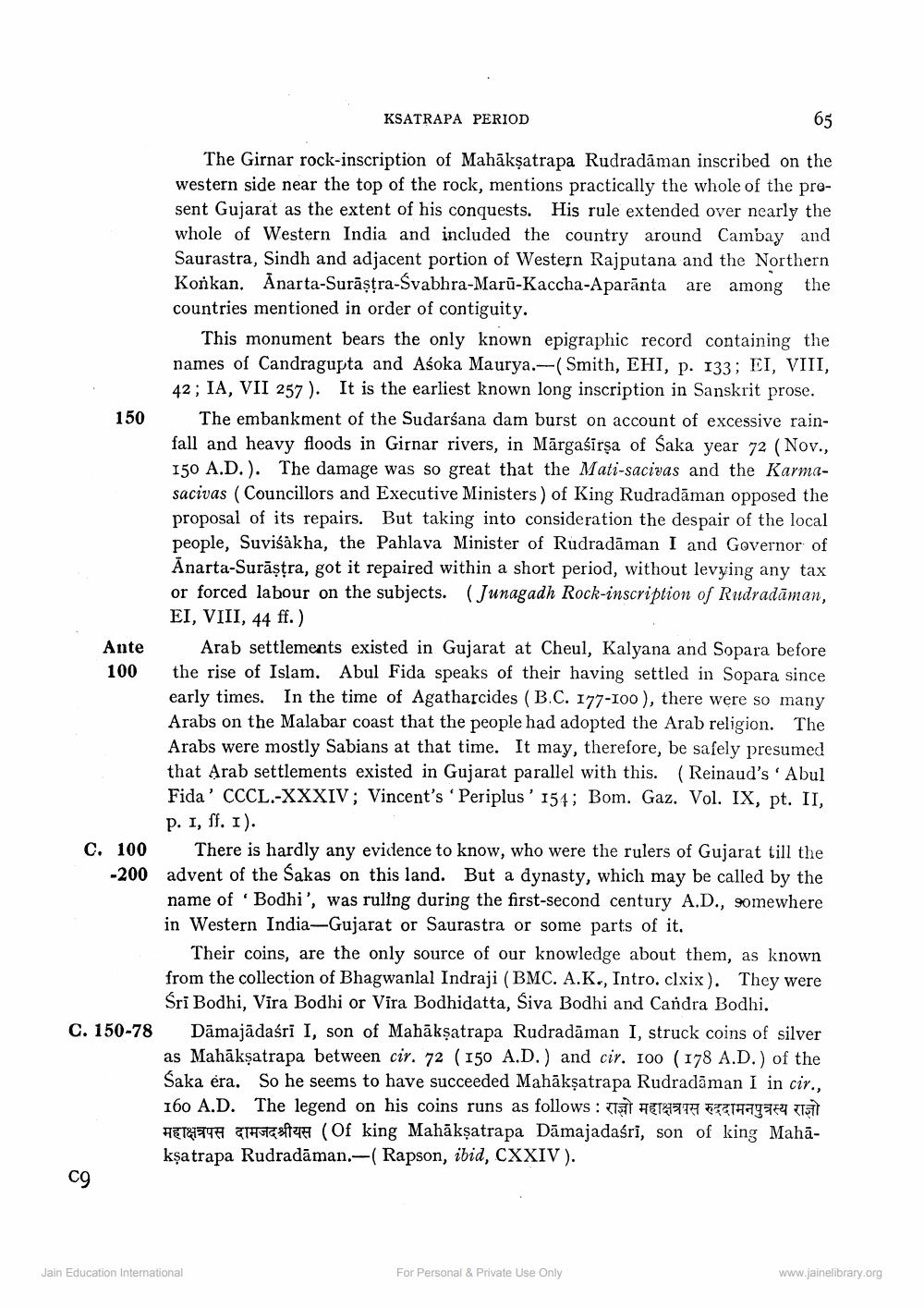________________
KSATRAPA PERIOD
The Girnar rock-inscription of Mahākṣatrapa Rudradāman inscribed on the western side near the top of the rock, mentions practically the whole of the present Gujarat as the extent of his conquests. His rule extended over nearly the whole of Western India and included the country around Cambay and Saurastra, Sindh and adjacent portion of Western Rajputana and the Northern Konkan. Anarta-Surāştra-Svabhra-Marū-Kaccha-Aparānta are among the countries mentioned in order of contiguity.
This monument bears the only known epigraphic record containing the names of Candragupta and Aśoka Maurya.-(Smith, EHI, p. 133; EI, VIII,
42; IA, VII 257 ). It is the earliest known long inscription in Sanskrit prose. 150 The embankment of the Sudarśana dam burst on account of excessive rain
fall and heavy floods in Girnar rivers, in Mārgasirşa of Saka year 72 (Nov., 150 A.D.). The damage was so great that the Mati-sacivas and the Karmasacivas (Councillors and Executive Ministers) of King Rudradāman opposed the proposal of its repairs. But taking into consideration the despair of the local people, Suvisakha, the Pahlava Minister of Rudradāman I and Governor of Anarta-Surāṣtra, got it repaired within a short period, without levying any tax or forced labour on the subjects. (Junagadh Rock-inscription of Rudradāman,
EI, VIII, 44 ff.) Ante Arab settlements existed in Gujarat at Cheul, Kalyana and Sopara before 100 the rise of Islam. Abul Fida speaks of their having settled in Sopara since
early times. In the time of Agatharcides (B.C. 177-100), there were so many Arabs on the Malabar coast that the people had adopted the Arab religion. The Arabs were mostly Sabians at that time. It may, therefore, be safely presumed that Arab settlements existed in Gujarat parallel with this. (Reinaud's 'Abul Fida' CCCL.-XXXIV; Vincent's 'Periplus' 154; Bom. Gaz. Vol. IX, pt. II,
p. I, ff. 1). c. 100 There is hardly any evidence to know, who were the rulers of Gujarat till the -200 advent of the Sakas on this land. But a dynasty, which may be called by the
name of Bodhi', was ruling during the first-second century A.D., somewhere in Western India-Gujarat or Saurastra or some parts of it.
Their coins, are the only source of our knowledge about them, as known from the collection of Bhagwanlal Indraji (BMC. A.K., Intro. clxix). They were
Sri Bodhi, Vira Bodhi or Vira Bodhidatta, Siva Bodhi and Candra Bodhi. C. 150-78 Dāmajādaśri I, son of Mahākṣatrapa Rudradāman I, struck coins of silver
as Mahākṣatrapa between cir. 72 (150 A.D.) and cir. 100 (178 A.D.) of the Saka era. So he seems to have succeeded Mahākşatrapa Rudradāman I in cir., 160 A.D. The legend on his coins runs as follows: 157 HTT47TH Thagara 15 HETH44 CTHEEAAh (Of king Mahākṣatrapa Dāmajadaấri, son of king Mahākşa trapa Rudradāman.-( Rapson, ibid, CXXIV).
Jain Education International
For Personal & Private Use Only
www.jainelibrary.org




